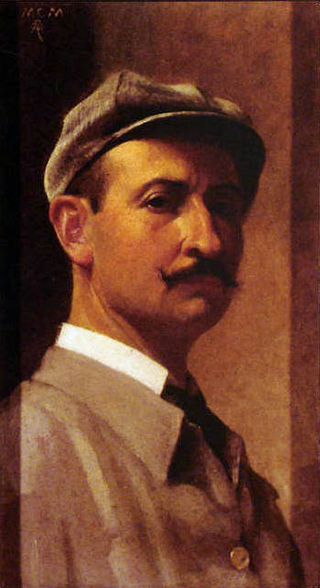Top Qs
Timeline
Chat
Perspective
Rodolfo Amoedo
Brazilian painter (1857–1921) From Wikipedia, the free encyclopedia
Remove ads
Rodolfo Amoedo (11 December 1857 – 31 May 1941) was a Brazilian painter, designer and decorator.
You can help expand this article with text translated from the corresponding article in Portuguese. (March 2018) Click [show] for important translation instructions.
|
Remove ads
Biography
Summarize
Perspective
His interest in art and decoration began when a family friend invited him to do work on the now defunct Teatro São Pedro. In 1873, he enrolled at the "Liceu de Artes e Ofícios do Rio de Janeiro", where he studied with Victor Meirelles. The following year, he transferred to the Academia Imperial de Belas Artes.[1] His teachers there included João Zeferino da Costa, Agostinho José da Mota and the sculptor Francisco Manuel Chaves Pinheiro. In 1878, his painting on the O Sacrifício de Abel narrowly won him a travel fellowship to study in Europe.[2]

From 1879 to 1887, he lived and studied in Paris. Initially, he attended the Académie Julian, but finally managed to enroll at the École des Beaux-arts in 1880, where he received the guidance of Alexandre Cabanel, Paul Baudry and Puvis de Chavannes.[1] From 1882 to 1884, he participated in the Salon while developing his primary themes of mythology, Biblical scenarios and Indianismo.[2]
In 1895, he painted Más Notícias.[3] He won a gold medal at the "Exposição Nacional Comemorativa do 1º Centenário da Abertura dos Portos do Brasil" (1908).[4]
He later became a Professor at the Escola Nacional de Belas Artes (ENBA), where he encouraged students to research the various process of painting (tempera, encaustic, watercolor etc.). He also served as Vice-Director and Acting Director on several occasions.[1]
In addition to his canvases, he painted panels for the Supremo Tribunal Federal in 1909, the Biblioteca Nacional and the Theatro Municipal do Rio de Janeiro in 1916.[4] Two years later, he was awarded the Second Chair in the School of Painting, a position he held until 1934. Among his best-known students were the brothers Arthur and João Timóteo da Costa, Lucílio de Albuquerque, Eliseu Visconti and Cândido Portinari.[4]
Remove ads
Selected paintings
References
Further reading
External links
Wikiwand - on
Seamless Wikipedia browsing. On steroids.
Remove ads





